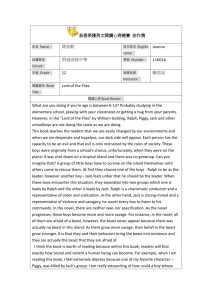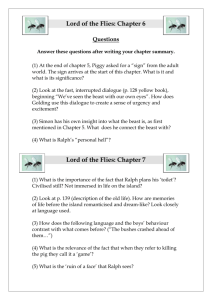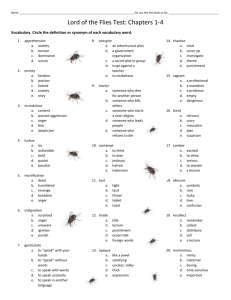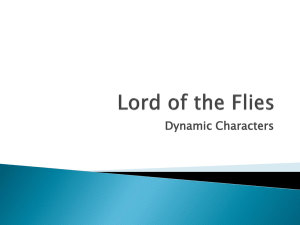AP English: Major Works Data Sheet
advertisement
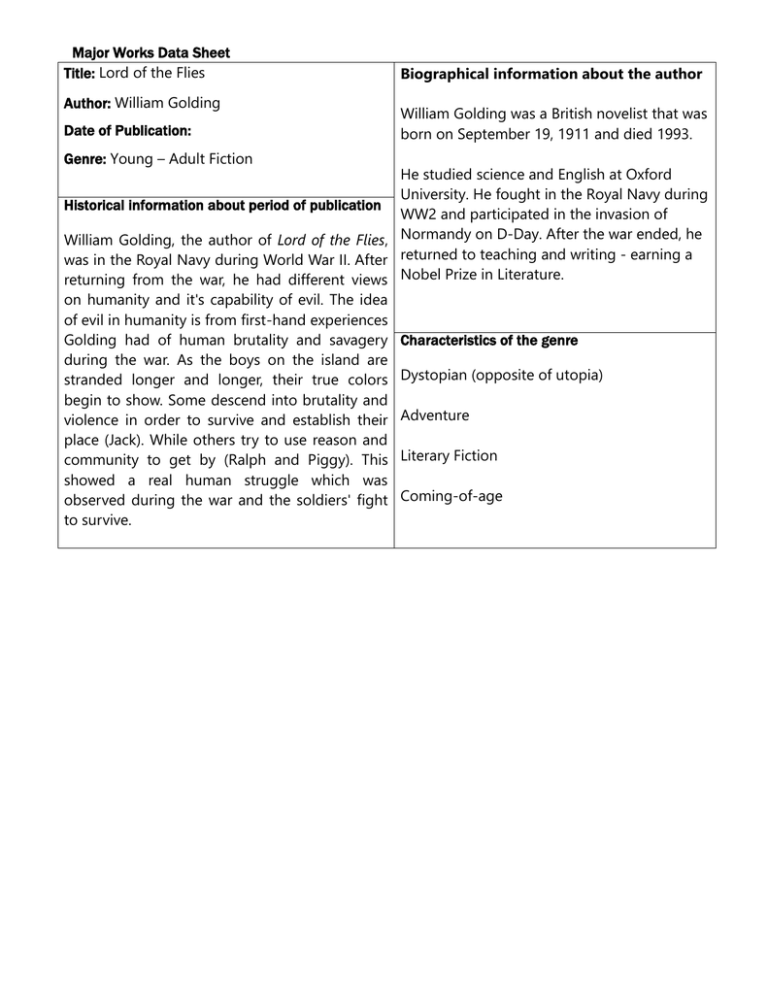
Major Works Data Sheet Title: Lord of the Flies Author: William Golding Date of Publication: Genre: Young – Adult Fiction Biographical information about the author William Golding was a British novelist that was born on September 19, 1911 and died 1993. He studied science and English at Oxford University. He fought in the Royal Navy during Historical information about period of publication WW2 and participated in the invasion of William Golding, the author of Lord of the Flies, Normandy on D-Day. After the war ended, he was in the Royal Navy during World War II. After returned to teaching and writing - earning a returning from the war, he had different views Nobel Prize in Literature. on humanity and it's capability of evil. The idea of evil in humanity is from first-hand experiences Golding had of human brutality and savagery Characteristics of the genre during the war. As the boys on the island are stranded longer and longer, their true colors Dystopian (opposite of utopia) begin to show. Some descend into brutality and violence in order to survive and establish their Adventure place (Jack). While others try to use reason and community to get by (Ralph and Piggy). This Literary Fiction showed a real human struggle which was observed during the war and the soldiers' fight Coming-of-age to survive. Plot summary After crashing on an island devoid of adults Ralph finds himself exploring the area alongside a boy named Piggy. Finding a conch Ralph summons the other boys scattered throughout the island together where they attempt to establish a society. Ralph is elected leader and he appoints another boy, Jack, to be in charge of the hunters. Ralph, Jack, and another boy Simon explore the island leading Ralph to conclude they need a signal fire. The immediately rush to create the fire with Piggy's glasses and burn down half the forest as it gets out of control having likely burned a littlun to death. At first the boys enjoy the island life playing all day although Jack becomes preoccupied with hunting and Ralph complains they should be spending time building shelter and maintaining the signal fire. One day a ship passes by without noticing them since the hunters let the signal fire out in order to catch a pig. When Piggy criticizes Jack he is struck across the face and Ralph calls a meeting. He lectures the boys but it becomes evident they are scared of a beast. A dead parachutist drops on the island and nobody notices since they are all sleeping. When Samneric awakes they see the silhouette of the man and believe it is the beast. After they alert the boys they set out on a hunting expedition finding nothing until Jack and Ralph travel up the mountain. After reporting to the group Ralph is deemed a coward by Jack and he says to elect him new leader. The group refuses and Jack storms off taking the hunters with him. Ralph gets the remaining boys to create a signal fire on the beach but the majority of the boys leave to join Jack before the job is done. Jack calls himself the leader of the new tribe with rituals of killing sows and sacrificing to the beast calling a feast for people to join his tribe. Simon finds the pig head sacrifice covered in flies and imagines it as Lord of the Flies telling him the beast is within them. Simon finds the beast doesn't exist externally after seeing the parachutist and goes to tell the boys. However he is killed as the boys are in the middle of a ritual and believe he is the beast. The next day as Piggy and Ralph discuss his death Jack steals Piggy's glasses. When Ralph and his few followers go to confront Jack chaos occurs. Samneric is tied up, Jack and Ralph begin to fight and in the midst of it Roger releases a boulder killing Piggy and demolishing the conch. Ralph barely escapes with his life hiding the night. The next day the boys hunt Ralph igniting the trees to smoke him out although it ends up acting as a signal fire and a naval officer finds the boys. They are saved but they weep for the loss of innocence and the darkness of a man's heart. Describe the author’s style Examples that demonstrate style Straightforward, gets right to the point when explaining without long explanations or poetic writing Allegorical, characters and objects are inspired by symbolic significance and The pigs head is savagery, the conch is civilization, and Jack is loss of innocence the themes of the novel Displays the many ways humans may respond to the situation at hand Jack is savage, Ralph is calm, and Piggy is rational Memorable quotations Significance of quotations 1. Roger gathered a handful of stones and began to throw them. Yet there was a space around Henry, perhaps six yards in diameter, into which he dare not throw. Here, invisible yet strong, was the taboo of the old life. Round the squatting child was the protection of parents and school and policemen and the law. This describes Roger’s first sign of cruelty to the littluns. At this point, civilized instinct is still more powerful than savagery. Roger feels like throwing stones at Henry, but his standards of good behavior are too strong for him to give in to. 2. “What I mean is… maybe it’s only us.” Simon is talking about the snake – like creature that the littluns are scared of. He is the first one to see evil inside humanity not just outside. 3. “There isn’t anyone to help you. Only me. And I’m the Beast… Fancy thinking the Beast was something you could hunt and kill… You knew, didn’t you? I’m part of you? Close, close, close! I’m the reason why it’s no go? Why things are the way they are?” This confirms Simon’s idea of the Beast being humanity. The Beast using the boys slang makes it appear even more evil because it uses familiar language that the boys use. Characters Name Role in story Significance Adjectives Ralph Leader of the group Calls meetings, brings all the boys together. Tries to build a miniature civilization Powerful, confident, hard working Piggy Ralph’s “lieutenant.” Comforts the littluns Tries to create peace and unity on the Fair, rational, island. Provides glasses to make the Smart fire Simon Shy, sensitive boy of the group. Only boy with a sense of morality Realizes the beast is inside the boys Shy, sensitive, insightful, kind Jack Becomes the leader of the hunters Longs for the power that Ralph has. Represents violence and savagery. Becomes obsessed with hunting after first not being able to kill a pig Cruel, dominant, selfish, arrogant Samneric A pair of twins who are always together They’re part of the group known as the “Bigguns.” Near the end of the novel they fall victim into Jack’s manipulation Respectful, united Roger Jack’s “lieutenant.” A sadistic Held responsible for brutalizing the littluns, and killing Piggy with a boulder Hurtful, rude, Setting Setting: the boys are stranded on an inhabited tropical island. Somewhere in the Pacific in the 1950s. The island contains thick jungle and dense undergrowth with plentiful food. (Wild fruit and pigs) Most of the story centers around the white beach at the lagoon area on the island. Symbols The conch – used to call assemblies, brings the boys into civilization. Symbolizes authority Piggy’s glasses – used to make the fire. Symbolizes science and technology on the island Significance of opening scene The significance in the beginning of the book: Ralph is the leader and tells the boys that the only way they will survive is if they have rules and orders. The first priority was to build a fire so it could signal a rescue plane. However Jack thought getting food for the group was the better option. They learned how to live on their own and follow and listen to each other. Significance of closing scene The significance in the end of the book: the death of some of the boys and Ralph barely making it out alive made him realize that the island was the death of the boy’s innocence and they could no longer consider themselves vulnerable children. Old AP questions a) Jack’s knife – used to kill the pig. Symbolizes safety and superiority The signal fire – brings the boys together and shows the boys’ connection to human civilization. Symbolizes hope Possible themes / Topics of discussion a) Need for social order – without adults, the boys The beast – scares the boys on the island. When the boys grow more savage, their fear of the beast grows too. Symbolizes that evil lives inside of everybody b) Lord of the flies – a bloody, severed sow’s head that Jack impales on a stake in the forest as an offering tothe beast. Symbolizes the evil and fear d) c) e) The island – the boys tried to make a deserted island feel like home. Symbolizes paradise The scar – symbolizes the beginning of everything bad War paint – Symbolizes becoming someone else, self–conscience f) g) create their own rules and create their own form of order and government Power – to Ralph, power is democratic. To Jack it is authority. The conch symbolizes power Vision – mirages impair their vision. Piggy has poor vision, but knows what the boys need to do to survive. Only Simon can see the beast Fear of the unknown – boys are afraid and do not know where they are. They all fear the beast Loss of identity – the boys lose their identities. The choir becomes hunters. The mask allows the boys to become someone else. Jack’s followers become a savage tribe. Ralph forgets the reason why rescue is important and Percival forgets his own name Loss of innocence – Ralph’s faith in democracy is shattered. Following rules offers no protection. Piggy’s belief in fairness is proven false and violence takes the lives of 3 boys Symbolism of the shell – symbolizes power and order. The one in possession of the shell has the authority to speak. When the shell shattered, any semblance of order is gone
